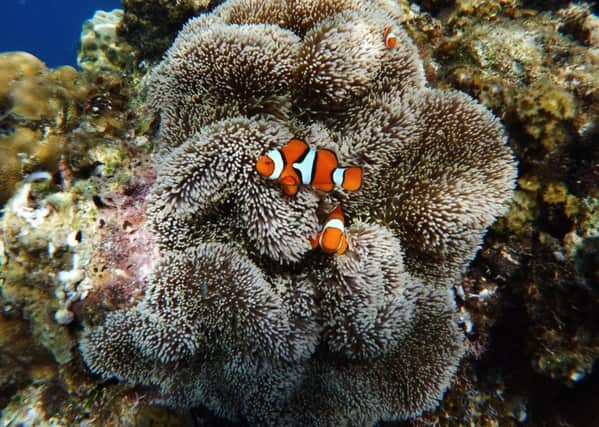Travel review: Kimbe Bay - Papua New Guinea's largest island


In and out. It should be a natural, straightforward process; something I’ve been practising all my life. But right now, only centimetres below the sun-dappled surface of the Bismarck Sea, I’m finding it hard to breathe.
Sucking a cocktail of nitrogen and oxygen through an aqua lung is an alien experience, although for dive master Jacques Cousteau, who invented the apparatus in the 1940s, it was probably easier than inhaling air.
Advertisement
Hide AdAdvertisement
Hide AdThis year marks 20 years since the death of the French marine giant who has inspired generations to explore and protect our oceans, so it’s fitting I should be making my first dive at a site where Cousteau enjoyed one of his last.
Papua New Guinea’s largest island, Kimbe Bay is one of the most biodiverse marine areas on the planet and forms part of the western Pacific’s Coral Triangle.
Accompanied by PADI instructor Liz, who’s leading my taster dive, I’m exploring the underwater wall at Restorf Island, a cluster of vegetation sprouting from the sea, with stride-in access to its coral gardens.
The wonders are plentiful: ethereal angelfish float through the brittle fingers of scarlet gorgonians, upstaging a shoal of sour-faced trevallies. In the crevices, Christmas tree worms timidly retract their tinselly bristles, and below, barrel sponges the size of chimneys spew a pick ’n’ mix of humbugs and other delights.
Advertisement
Hide AdAdvertisement
Hide AdSuch biodiversity inspired Australian couple Max and Cecilie Benjamin to open a dive resort at Kimbe Bay in 1983. Set against a backdrop of volcanic peaks in a palm oil plantation, the Walindi Plantation Resort features bungalows with kitchenettes spread along a jungle path.
Since learning to dive in the area, Cecilie and her husband have plotted around 60 dive sites and professional divers and underwater photographers from all over the world regularly visit.
Many divers bring their own gear, but excellent equipment can also be rented from the lodge. Alternatively, there’s the option to snorkel in Kimbe Bay’s warm, clear waters.
A 10-minute boat ride from Walindi, I’m gliding along a sheer vertical ledge known as the Hanging Gardens. Here, there’s no need to go deep: tangles of rope sponge trail from overhangs and cantankerous clown fish fiercely guard the writhing walls of their anemone castles.
Advertisement
Hide AdAdvertisement
Hide AdSeveral stations are dotted along the wall, part of a study into the hierarchy of clown fish communities who operate a strict 20 per cent size differentiation when selecting residents for anemones, the only place where they can safely survive.
It’s one of the many projects supported by Mahonia Na Dari, a research institute set up by Max Benjamin and inspired by Cousteau. Translated as Guardian of the Sea, the centre also aims to educate the local community about the marine riches on their doorstep.
The institute also supports several terrestrial projects, and birding tours are a growing arm of the Walindi business. Driving along tarmac roads past regimented rows of thick-stemmed splaying palms, I find it hard to imagine any natural vegetation remains; much of New Britain has been cultivated, mainly by Malaysian and Indonesian firms.
But birds are adapting and even capitalising on their new environment, says Joseph, a fast-talking and jovial local man who leads birding tours. A prime example is the golden masked owl, an elusive night creature which disappeared from this area in the Seventies but has been seen occasionally since 2015.
Advertisement
Hide AdAdvertisement
Hide Ad“They come to catch the mice and rats feasting on rotting palm fruit,” adds Joseph as we weave past trucks piled high with the blood-red bunches, their pulp exuding a sickly sweet, overripe smell.
But despite a silver light bulb illuminating the sky, our owls remain masked by darkness; the full moon is apparently a hindrance to their hunting.
Along with tracking rare owls, Joseph also guides walks to find nicobar pigeons (a close relative of the dodo) and intriguingly-named megapodes. Using a machete to slice through layer-upon-layer of thick ferns and spiralling vines, he clears our path to a thermal lake and hot springs where megapodes incubate eggs in the warm ground. But any images of prehistoric fauna are quickly banished when I catch sight of the Melanesian scrubfowl (as it’s more commonly known) which bears more resemblance to a chicken.
Despite conservation efforts, these birds are still hunted by the local community and their eggs collected for food. It’s a sobering reminder that we’re in a developing country where economic demands can be at odds with environmental needs. Yet there is hope.
Advertisement
Hide AdAdvertisement
Hide AdWalindi is striving to safeguard the island’s treasures and preserve a place which Cecilie once described as “our undiscovered universe”, keeping the GPS co-ordinates of their dive sites under lock and key.
But in a world where Cousteau complained “water and air, the two essential fluids on which all life depends, have become global garbage cans,” it won’t be easy.
The only option is to take a breath – and dive in.
GETTING THERE
Reef and Rainforest Tours (reefandrainforest.co.uk, 01803 866965) offers a 14-day Natural History Highlights Tour of Papua New Guinea which includes three nights at Walindi from £7,185 per person including international flights via Singapore.